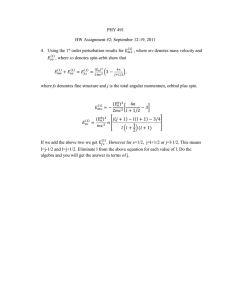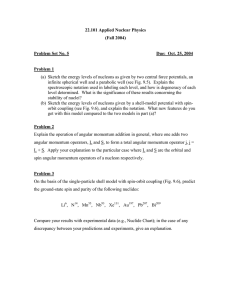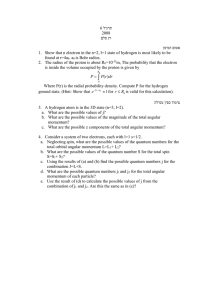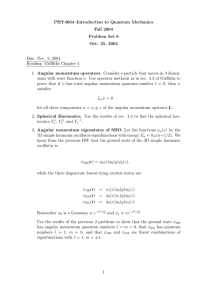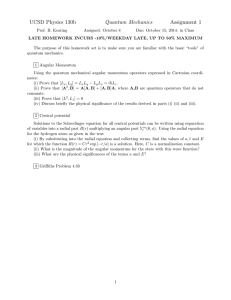Spin-orbit interaction (or “coupling”)
advertisement
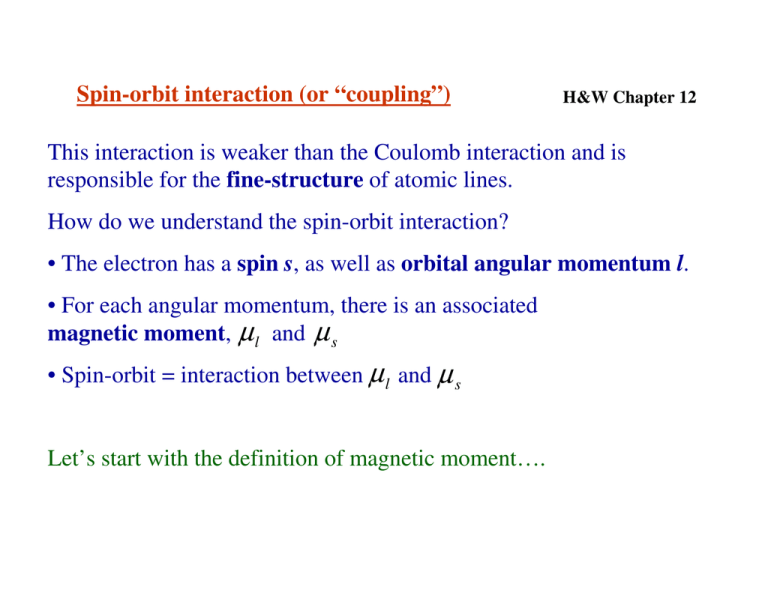
Spin-orbit interaction (or “coupling”) H&W Chapter 12 This interaction is weaker than the Coulomb interaction and is responsible for the fine-structure of atomic lines. How do we understand the spin-orbit interaction? • The electron has a spin s, as well as orbital angular momentum l. • For each angular momentum, there is an associated magnetic moment, µ l and µ s • Spin-orbit = interaction between µ l and µ s Let’s start with the definition of magnetic moment…. Magnetic moment µl electron orbit = current loop the magnetic moment is defined as and A the area of the orbit. µl = I ⋅ A where I is the current µ l is a vector perpendicular to the plane of the orbit. Now let’s show that µ l is linked to the orbital angular momentum: orbit period T= 2π ω − e − eω I= = T 2π r l A − eω 2 1 µl = I ⋅ A = πr = − eωr 2 2π 2 orbital ang. mom. r r r l = r × p = m0 vr = m0ωr 2 + r r e v µl e r µl = − l 2m0 r r Note that µ l and l point in opposite directions because the electron is r negatively charged. Let’s consider the case l = h : this is the orbital angular momentum of the ground state in Bohr’s theory, and is therefore taken as the unit of angular momentum in atoms. The modulus of the corresponding magnetic moment is known as Bohr magneton: eh µB = 2mo Bohr magneton It is unit of magnetic moments in atoms. More generally, for a state with quantum numbers l and ml : r Modulus l = h l (l + 1) r e µl = h l (l + 1) = µ B l (l + 1) 2mo Component along z µl , Z e =− l z = − µ B ml 2mo lZ = ml h with ml = 0,±1,±2.... ± l magnetic quantum number We also can apply these definitions to the electron spin…. Electron spin • An intrinsic property like charge or mass. • Its existence proven by Stern-Gerlach experiment (see later), and justified by Dirac’s relativistic quantum theory. 1 • It’s an intrinsic angular momentum with quantum number s = 2 Hence we can apply the same theory that we saw for the orbital angular momentum (see Hydrogen atom- angular momentum aside). r 3 h Modulus s = s ( s + 1)h = 2 Component along z sZ = ms h 1 (with ms = ± ) 2 Spin magnetic moment r e r µs = − gs s 2mo Where g s = 2.0023 is a numerical factor known as the Lande factor (or “g factor”). Classically it should be 1, but is 2 according to Dirac’s relativistic quantum theory. ( g l = 1 for orbital angular momentum) Next, let’sr consider the magneticrinteraction of a magnetic moment µ with a magnetic field B : r µ r torque τ = µ × B r α r B Magnetic potential energy: α Vmag α r r = ∫ ( µ × B )dα = ∫ µB sin αdα = − µB[cos α ]απ / 2 = π /2 r r = − µB cos α = − µ ⋅ B π /2 Vmag r r = −µ ⋅ B (Note that the potential energy is minimised if magnetic moment is parallel to B, i.e. α=0.) Spin-orbit interaction r Vl , s = − µ s ⋅ Bl r r s Orbiting proton produces a field Bl at the site of the electron. r Bl -r r Bl s r Bl r The spin, hence µ s , has two possible orientations with respect to the field: “parallel”, with lower energy, and “anti-parallel” with higher energy we expect energy levels in atoms to split in two (fine structure). Note that this is not the only magnetic interaction that is taking place in an atom. The nucleus also has a spin, hence a magnetic moment. The nuclear magnetic moment interacts with the magnetic field produced by the orbiting electron. This interaction is much weaker than the spin-orbit interaction considered here, and is responsible for the hyperfine structure of the energy levels – see later. Our goal is to determine an expression for the fine structure starting r r from Vl , s = − µ s ⋅ Bl . Let’s start by writing the B-field in terms of the orbital angular momentum: Biot-Savart law: r r r l = r × m0 v r r r − l = m0 v × r r Zeµ 0 r r Zeµ 0 r r Bl = [v × (− r )] = − [v × r ] 3 3 4πr 4πr The – sign here is because we are in the electron’s frame of reference, see previous slide r Zeµ 0 r Bl = l 3 4πr m0 r 1 Zeµ 0 r Bl = × l 3 2 4πr m0 from full relativistic calculation (“Thomas factor”) r e r e r µs = − g s s ≈− s 2mo mo ( g s ≈ 2) 2 r Ze µ 0 r r e r Vl , s = ( s ⋅ Bl ) = (s ⋅ l ) 2 3 m0 8πm0 r We define the spin-orbit coupling constant a: Ze 2 µ 0 h 2 a= 2 3 8π m0 r a r r Vl , s = 2 l ⋅ s h (With this definition a has the dimension of an energy.) The constant a is measurable from spectra. We won’t do the calculation, but it can be shown that from expectation value Z4 a∝ 1 1 * 1 3 = ∫ψ 3ψdV n l l + (l + 1) 3 r r 2 Heavier atoms Larger n larger spin-orbit coupling smaller spin-orbit coupling r r r r … let’s now consider the scalar product l ⋅ s = l s cos(l , s ) . It is possible to express this in terms of the total angular momentum: r s r r r j =l +s rr r2 r2 r2 j = l + s + 2 l s cos(l , s ) r l r j a r2 r2 r2 Vl , s = 2 ( j − l − s ) 2h (These vectors are operators in quantum mechanics) ˆj 2 lˆ 2 sˆ 2 Properties of r j: • It is an angular momentum, hence we can apply the results we saw in the “angular momentum aside”. new quantum numbers j and m j such that: modulus^2: ˆj 2 Ψ = h 2 j ( j + 1)Ψ projection along z-axis: ˆj z Ψ = hm j Ψ • We have the commutation relations [ ] [ with j = with integer 1 3 = , 1, , ... 2 2 2 m j = j , j − 1,..,− j [ˆj , lˆ ] = 0 , [ ˆj , sˆ ] = 0 2 2 2 2 ] (which follow from ˆji , lˆ 2 = ˆji , sˆ 2 = 0 where i = x, y, z ) hence we can choose a set of common eigenfunctions of lˆ 2 , sˆ 2 , ˆj 2 , and calculate Vl , s on these eigenfunctions…. … and so we can replace the operators with the corresponding eigenvalues: a r2 r2 r2 a Vl , s = 2 ( j − l − s ) = [ j ( j + 1) − l (l + 1) − s( s + 1)] 2h 2 This is our final result for spin-orbit coupling: shift in energy due a Vl , s = [ j ( j + 1) − l (l + 1) − s ( s + 1)] to spin-orbit coupling 2 But we still haven’t discussed how to calculate j…. From the theory of coupling of angular momenta, it turns out that j = l±s = l± 1 2 e.g. for a p state (l=1) j=1/2 j=3/2 Example: fine structure of sodium atoms j = 1 / 2 and Vl , s = 0 • state 3s (l=0) there is no fine structure (physically, there is no angular momentum, hence no “current loop” and Bl = 0 ) • state 3p a 3 5 1 3 a j=3/2 and Vl , s = ⋅ − 2 − ⋅ = 2 2 2 2 2 2 a 1 3 1 3 j=1/2 and Vl , s = ⋅ − 2 − ⋅ = −a 2 2 2 2 2 fine structure for 3p a/2 a j=3/2 j=1/2 3 a 2 3s 3p transition is split into a doublet (D lines: D1 and D2) Sodium doublet viewed in a FabryPerot interferometer: Nomenclature for naming energy terms: spin term principal quantum number n 2 s +1 lj total angular momentum orbital angular momentum from earlier =s,p,d,f etc... e.g. ground state of sodium is 2 3 s1/ 2 (the spin term is sometimes omitted, like in the previous slide, because it’s the same for all the levels.) Let’s see how the spectral lines split due to fine-structure: • series 3s np: pairs of lines (all p states are double) • series 3p nd: triple lines This is because: j=5/2 d state (l=2) j=3/2 and furthermore we have a new selection rule on j hence only these three transitions are allowed: 3 p3 / 2 3 p1/ 2 n d5/ 2 n d3/ 2 ∆j = ±1,0 Summary for FINE STRUCTURE r a r r • Vl , s = − µ s ⋅ Bl = 2 l ⋅ s spin-orbit coupling h r • all energy states (except s-states) are split into dublets • split ∝Z 4 (larger split in heavy atoms) But this is not the end with fine structure…. …Hydrogen is a special case: Small spin-orbit comparable to relativistic corrections (remember Bohr-Sommerfeld: in that model the fine structure was due to relativistic effects) In heavier atoms, spin-orbit coupling is stronger and relativistic effects can be neglected. For the H-atom: gross structure − Ry / n 2 fine structure E FS 6474 8 } E = En + Erel + El , s relativistic mass change spin-orbit coupling e µ0 r r (s ⋅ l ) 2 3 8πm0 r 2 Result from Dirac’s relativistic theory: EFS Enα 2 1 3 =− − n j + 1 / 2 4n e2 1 = where the dimensionless quantity α = 2ε 0 hc 137 is the fine structure constant. (You can verify that α=v/c with v= velocity of 1st Bohr orbit.) Example: let’s apply this result to the n=2 level of Hydrogen. Here we have an s state and a p state: l = 0 ⇒ j = 1/ 2 l = 1 ⇒ j = 1 / 2, 3 / 2 Bohr Can calculate E FS for these values of j Dirac QED (relativistic QM) n=2 2 2 p3 / 2 l=1, j=3/2 2 2 s1/ 2 ≈ 10GHz l=0,1, j=1/2 1057 MHz 2 2 p1/ 2 This is a further splitting that can only be explained by Quantum Electrodynamics (QED)… … this is known as the Lamb shift of the s level. It was first observed in 1947-1952 and was crucial for the development of QED. Significance of Lamb shift In QED the electromagnetic field is quantised. A quantised field has a zero point energy (analogous to the ground state of the simple harmonic oscillator). This means that even in the case of number of photons=0 (“vacuum”), there is a fluctuating electric field. Due to this fluctuating field the electron performs small oscillations and its charge is effectively smeared out. It can be shown that the Coulomb potential acting on the electron is different than that for a point charge. This difference causes the Lamb shift. (Note: this fluctuating electric field is also responsible for spontaneous emission.)
